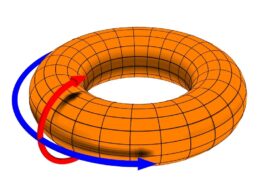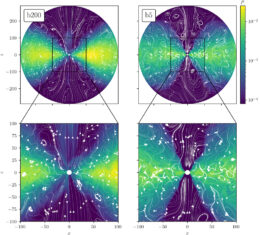Do models of turbulent, magnetized gas in accretion disks around black holes “remember” the conditions they started with, or is that information washed away as the model evolves?
Magnetic Fields and Accretion Disks
If you’re an astronomer, you may already know this joke: an astronomer is speaking with a therapist, discussing a recent bout of sleeplessness. The therapist asks, “What do you think it is that’s keeping you up at night?” Staring wide-eyed at the ceiling, the astronomer whispers, “Magnetic fields…”
Today’s article presents one example of why astronomers might lose sleep over magnetic fields. Magnetic fields are a key component of accretion disks, which feed material to growing stars, black holes, and other objects. Researchers have had great success in modeling magnetized accretion disks, but the huge computational cost of increasingly complex models has prompted the use of time-saving shortcuts with the potential for unintended side effects.
Testing a Model’s Memory
One way to speed up simulations is to start out with the model’s magnetic fields close to the desired end state. Recently, Payton Rodman (University of Cambridge) and Christopher Reynolds (University of Cambridge and University of Maryland) tackled the question of whether it matters what kind of magnetic fields a model starts with when simulating accretion disks around supermassive black holes.

Illustration of the poloidal (red arrow) and toroidal (blue arrow) directions. [Wikipedia user DaveBurke; CC BY 2.5]
To save time, many models start out with a strong poloidal magnetic field. However, real accretion disks might instead start out with weak toroidal magnetic fields, which circle the black hole horizontally. If all magnetic fields, regardless of initial strength of configuration, “forget” their initial state and eventually evolve into the strong poloidal fields that researchers observe, that means that modelers can choose any reasonable starting parameters. If the magnetic fields retain a memory of their initial state, modelers will need to carefully examine their starting conditions and how the fields evolve.
A Clear Imprint
Rodman and Reynolds compared the evolution of weak and strong toroidal magnetic field models to test the “memory” of their accretion disk model. They found that the weak and strong magnetic field simulations diverged quickly and didn’t reach the same end point — the final outcome retained an imprint of the initial field strength.

Magnetic field streamlines for simulations with a weak initial magnetic field (left) and a strong initial magnetic field (right). Click to enlarge. [Rodman & Reynolds 2024]
The results of this study make it clear that initial magnetic field conditions must be chosen carefully, as accretion models appear to have long memories. Future work should delve into this issue further, hopefully helping astronomers everywhere to rest easier.
Citation
“Evolution of the Magnetic Field in High- and Low-β Disks with Initially Toroidal Fields,” Payton E. Rodman and Christopher S. Reynolds 2024 ApJ 960 97. doi:10.3847/1538-4357/ad0384

